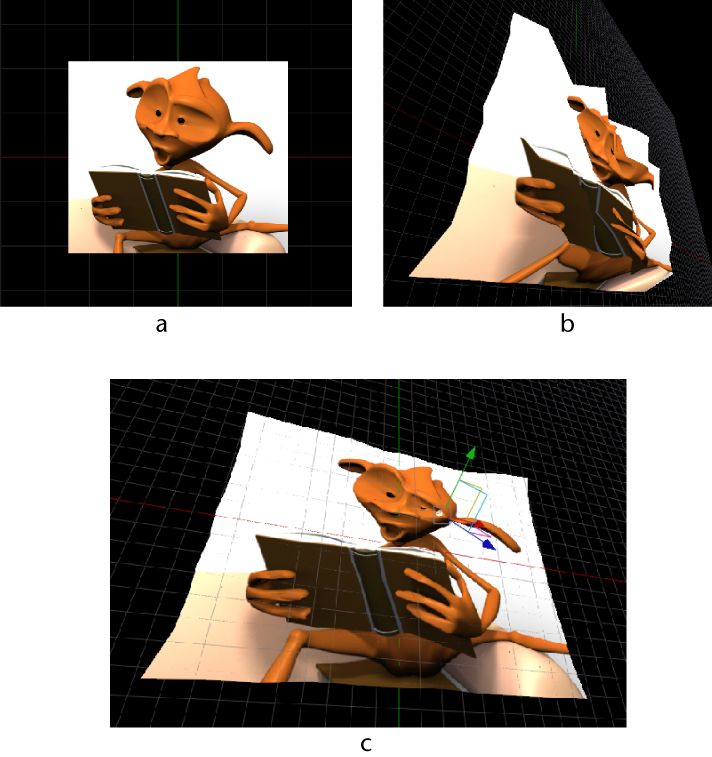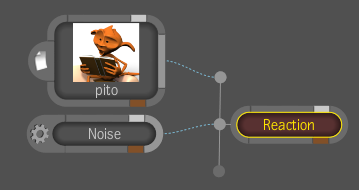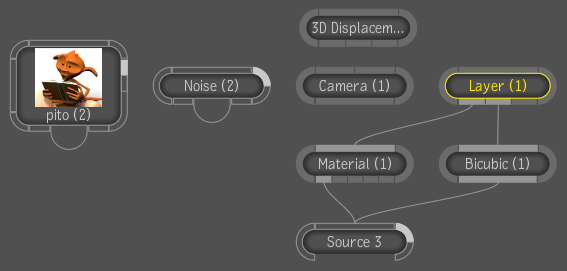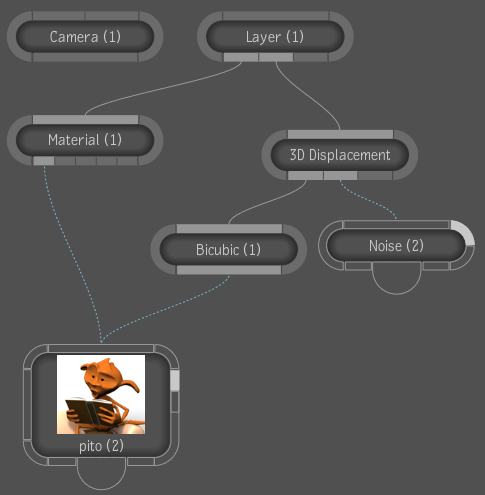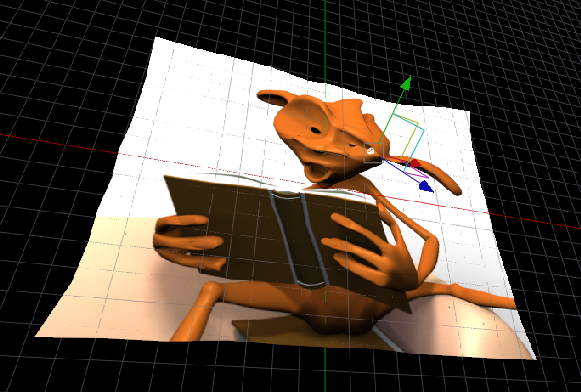The 3D Displacement tool
lets you add depth to meshes created in or imported into Composite.
The pixel values in an image are used to displace vertices. This
allows the illusion of perspective to be maintained as the camera
is moved in 3D space. You can also create a displacement that converges
on an object, such as a light. Once created, you can blur the displacement,
as well as set the tiling.
NoteThe 3D Displacement
tool can only perform displacement on images with sufficient geometry.
If the image you are using does not contain sufficient geometry,
you can increase it by adjusting the width and height of segments
in the Surfaces tab of Reaction.
To use the 3D Displacement tool:
- Select File > New or press Ctrl + N (for Windows and Linux)
or Cmd + N (Mac
OS) to start a new composition.
- From the Tools tab, select Camera from
the Reaction folder and drag it to the Schematic view.
- You will need two sources, one for the
image to be displaced and another for the image that will do the
displacing. Right-click the Reaction node and select Add Source.
Repeat to add another source.
- Select the Reaction node. In the tool
UI, select the Render tab and click Z-Buffer—see
Enabling Z-Buffer Effects in Your Scene.
- Add the two images you want to use to
the Schematic view, connecting one to each source. In the following
example, the Noise image generator is used to displace the character.
- Display the Group Schematic by double-clicking
the Reaction node or right-clicking the Reaction node and selecting
Edit Group.
- From the Tools tab, select 3D Displacement
from the Reaction folder and drag it to the Group Schematic.
- In the Layer Editor, click Create to
add a new layer.
- Delete the Source node and arrange the
nodes as follows:
- Select the 3D Displacement node. In the
tool UI, you can adjust the following parameters:
| Parameter |
Description |
| Amount |
Amount of displacement in the image. Positive values
make the displacement protrude and negative values invert the displacement.
NoteThe displacement
occurs in Reaction units (Amount times the displacement image values
minus the Offset).
|
| Offset |
The value that is subtracted from the displacement image values
before it is interpreted as a displacement. It is used to determine
the value of the displacement image that yields no displacement.
|
| Type |
- Surface Orients
the displacement towards the surface normal.
- Toward Target Orients
the displacement towards a target which can be a light, locator,
axis, camera, layer, or 3D object.
- RGB > XYZ Specifies
the displacement by using the explicit XYZ components of the displacement
in the RGB channels of the image.
|
| Channel |
Set the channel for displacement: Luma, Red, Green, Blue, Alpha. |
| Convergence |
Used with the Toward Target type. The displacement converges
or is parallel to the target.
|
| X Radius, Y Radius |
Set the amount of blur to apply in the X or Y direction. |
| Link |
Couple the X and Y Radius so that when you change the
X Radius or Y Radius, the other changes in the same proportion.
|
| Tiling X, Tiling Y |
Set the repeat mode: Transparent, Edge, Repeat, and Mirror. |
- To make the displacement point towards
a target, set the Type to Toward Target. Set Convergence parameter;
the displacement can converge on the target or be parallel to it.
- From the Tools tab, select the Reaction
folder and drag one of the following to the Group Schematic: Axis,
Camera, Layer, Light, or Locator.
- Connect the target to the Target tab
of the 3D Displacement node. In the following example, a light was
added as the target.
- Select the Light node. In the Lights
tab, adjust the light to your liking—see
Working with Lights.
- Select the 3D Displacement node and adjust
the Amount until you have the desired result.
The image is starting
to displace towards the light object.
